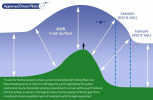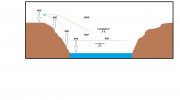OK, so I have to concede, the FAA defines structures as man-made, landforms do not count. However, they do consider the sidewall to be land, so as long as you are within 400' of the cliff, you are still 400' from the "land" and therefore still legal. This is literally the image sent to me from the FAA, showing 625' AGL straight down, yet still legal, with no "structures" in sight. With only requiring you to be <400' from the closest point of land. Yes, this image is not an FAA Drawing, and they admitted to such in the email, but it is what they sent to explain.

They also made clear that this is for Part 107, not TRUST, and that you still have to maintain all other provisions, I.E. VLOS, etc. Notice the 2 blue dotted lines showing 625' and 450' AGL, while maintaining 400' from the closest point of land.
So I was correct, you can traverse a Cliff wall, by staying less than 400' away from it, just my reasoning was incorrect.
As for the
@dronerdave 's example, yes, you would have been at fault because of the see and avoid provision, that you always yield right of way to manned aircraft, even if you are flying legally and they are not, you still have to avoid them.
Would you have been cited for an altitude violation? I do not think so, but you still would have failed to yield right of way.
As for the question from
@Heavydpj yes you would have been in violation, but not by 500', but more like .03125 ft, because that is the distance from the closest point of "land" when you make a 5'x400' right triangle flying over it. Lose a ft of altitude and the email from the FAA says you would be fine.












